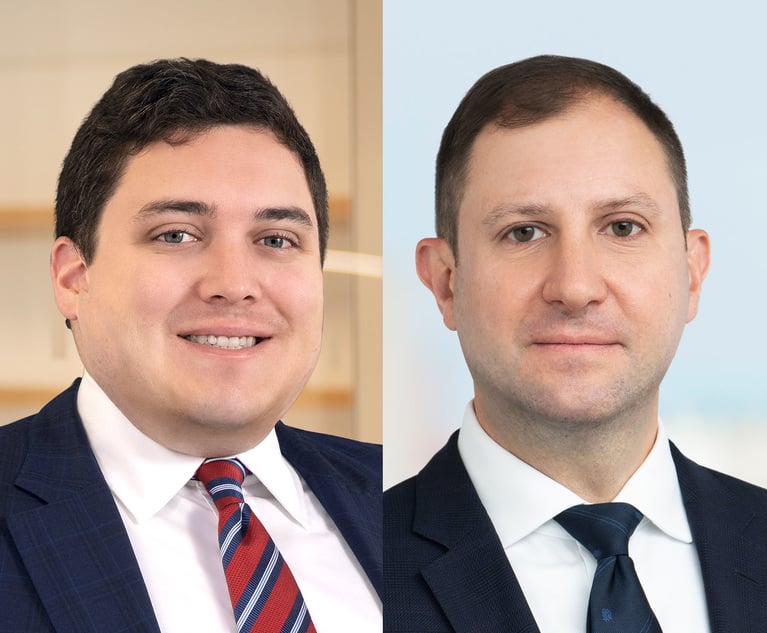Singing the Praises of Project Save
Project Save was founded in Gloucester Township in 2014 as an effort to provide counseling and treatment options to defendants with substance related issues resulting in offenses, and to address underlying issues leading to municipal court offenses.
February 11, 2020 at 10:30 AM
5 minute read
 Credit: Marian Weyo/Shutterstock.com
Credit: Marian Weyo/Shutterstock.com
December 1, 2019, marked the date that sentencing provisions for most DWI offenses changed. These changes eliminated the penalty of drivers' license suspension in favor of interlock installation for most first and second DWI offenses.
This major change in approach was based upon a statement of public policy enunciated by the Legislature reflecting its attitude toward what public policy should be for reducing recidivism after DWI convictions. It first pointed out that interlock devices were not required for some first offenders, with blood alcohol content under .15% BAC. As to these offenders, the Legislature found that, since "a majority of drunk drivers, including first offenders, often continue to drive with suspended licenses, ignition interlock devices (IID) are more effective in deterring drunk drivers than license suspension." After referring to some statistics in further findings, the Legislature summed up its argument for IID's by stating in its final finding that, "Therefore, it is fitting and proper to require all first time offenders, to install an ignition interlock device."
It's hard for me to understand this explanation. Were the DWI sentencing provisions fundamentally changed simply for these reasons? I don't believe that major revision of our entire statutory scheme of DWI sentencing was simply based upon the Legislature's concern for what a small portion of DWI offenders, that is first offenders with under .15% BAC, did during, for the most part, their three or at most seven months of suspension. Remember that the law as it stood before the change required interlock installation for every offense other than the least serious offense. In return for this change, there are effectively, no suspensions of driving privileges for most first offenders where alcohol was consumed.
Regardless of why this legislation was adopted, it misses the mark if its goal was truly to improve safety in motor vehicle operation. Mistakes from substance misuse can be understandable, sometimes not. Bad judgment, social pressure, lack of self-esteem, anxiety, poor pain management, addiction to medication, and depression can result in showing just how fragile life is. Obviously, one size does not fit all when it comes to addressing these problems. Some however, think differently when it comes to motor vehicle operation. For those who seek simple solutions to solve difficult problems, the new "wonder drug" is the ignition interlock device or IID. These devices would do what suspensions could not. If the car won't start, then it cannot be operated, and the problem is solved.
To find the best solution to any problem, you need to start with the right question. If the question is how to prevent prior offenders from operating vehicles without an unsafe level of alcohol in their bodies, then interlock devices might be an effective short term tool. But the substance abuse problems are not addressed and not resolved.
The same issues leading to the poor operation in the first place will be repeated after the interlock device has been removed. The IID, furthermore, only detects alcohol on the breath, not marijuana or other drugs that can adversely affect vehicle operation. This is not a solution then, as the interlock device is incapable of changing the driver's behavior after the interlock device is removed.
To me, it seems that the real issue is how to keep drivers convicted of DWI sober longer. Other states have adopted legislation that seriously addresses this issue. Understanding that alcohol and other types of substance misuse involving vehicle operation requires more than a quick fix, these states have implemented programs that allow probation before judgment, rewarding extended counseling and good behavior with driving privileges and ultimate expungement for first offenders.
Other types of technology are also available that address the substance problem, not just the operation. The National Highway Transportation Safety Administration recently studied the effect of Alcohol Monitoring Systems that are worn and provide ongoing data as to substance use. They found these devices to be effective in preventing recidivism.
Truth be known, like most other things in life, there are very few quick fixes. Usually sleeves have to be rolled up, elbow grease applied, and a large dose of patience is required. When it comes to addressing substance issues, even larger doses of hard work are required, which leads to a program that works with defendants' substance issues after they are charged with offenses that are heard in Municipal Courts. One program that has taken on this challenge is Project Save.
Project Save was founded in Gloucester Township in 2014 as an effort by the Gloucester Police Department and Genesis Counseling Center, to provide counseling and treatment options to defendants with substance related issues resulting in offenses, and to address underlying issues leading to Municipal court offenses. A program representative in court engages people who could benefit from their services. The program will then, "facilitate partnerships involving not only the police department, but most importantly, the Municipal Court Judge, Municipal Prosecutor and the Municipal Court Administrator" to enable defendants the best opportunity to address and resolve substance problems. The hope is to make a difference on an individual-by-individual basis, with an ultimate goal of creating a Drug Court for Municipal Courts.
Substance problems are difficult and challenging. Quick fixes only work for a short time. We have to do the hard work that this problem demands. Project Save has the right idea. We need more programs that help people change their lives when it comes to substance use.
Peter H. Lederman is a partner with Lomurro, Munson, Comer, Brown & Schottland in Freehold. His practice is limited to representing defendants charged with DWI and related offenses.
This content has been archived. It is available through our partners, LexisNexis® and Bloomberg Law.
To view this content, please continue to their sites.
Not a Lexis Subscriber?
Subscribe Now
Not a Bloomberg Law Subscriber?
Subscribe Now
NOT FOR REPRINT
© 2025 ALM Global, LLC, All Rights Reserved. Request academic re-use from www.copyright.com. All other uses, submit a request to [email protected]. For more information visit Asset & Logo Licensing.
You Might Like
View All
Neighboring States Have Either Passed or Proposed Climate Superfund Laws—Is Pennsylvania Next?
7 minute read
An Overview of Proposed Changes to the Federal Rules of Procedure Relating to the Expansion of Remote Trial Testimony
15 minute readTrending Stories
- 1New York-Based Skadden Team Joins White & Case Group in Mexico City for Citigroup Demerger
- 2No Two Wildfires Alike: Lawyers Take Different Legal Strategies in California
- 3Poop-Themed Dog Toy OK as Parody, but Still Tarnished Jack Daniel’s Brand, Court Says
- 4Meet the New President of NY's Association of Trial Court Jurists
- 5Lawyers' Phones Are Ringing: What Should Employers Do If ICE Raids Their Business?
Who Got The Work
J. Brugh Lower of Gibbons has entered an appearance for industrial equipment supplier Devco Corporation in a pending trademark infringement lawsuit. The suit, accusing the defendant of selling knock-off Graco products, was filed Dec. 18 in New Jersey District Court by Rivkin Radler on behalf of Graco Inc. and Graco Minnesota. The case, assigned to U.S. District Judge Zahid N. Quraishi, is 3:24-cv-11294, Graco Inc. et al v. Devco Corporation.
Who Got The Work
Rebecca Maller-Stein and Kent A. Yalowitz of Arnold & Porter Kaye Scholer have entered their appearances for Hanaco Venture Capital and its executives, Lior Prosor and David Frankel, in a pending securities lawsuit. The action, filed on Dec. 24 in New York Southern District Court by Zell, Aron & Co. on behalf of Goldeneye Advisors, accuses the defendants of negligently and fraudulently managing the plaintiff's $1 million investment. The case, assigned to U.S. District Judge Vernon S. Broderick, is 1:24-cv-09918, Goldeneye Advisors, LLC v. Hanaco Venture Capital, Ltd. et al.
Who Got The Work
Attorneys from A&O Shearman has stepped in as defense counsel for Toronto-Dominion Bank and other defendants in a pending securities class action. The suit, filed Dec. 11 in New York Southern District Court by Bleichmar Fonti & Auld, accuses the defendants of concealing the bank's 'pervasive' deficiencies in regards to its compliance with the Bank Secrecy Act and the quality of its anti-money laundering controls. The case, assigned to U.S. District Judge Arun Subramanian, is 1:24-cv-09445, Gonzalez v. The Toronto-Dominion Bank et al.
Who Got The Work
Crown Castle International, a Pennsylvania company providing shared communications infrastructure, has turned to Luke D. Wolf of Gordon Rees Scully Mansukhani to fend off a pending breach-of-contract lawsuit. The court action, filed Nov. 25 in Michigan Eastern District Court by Hooper Hathaway PC on behalf of The Town Residences LLC, accuses Crown Castle of failing to transfer approximately $30,000 in utility payments from T-Mobile in breach of a roof-top lease and assignment agreement. The case, assigned to U.S. District Judge Susan K. Declercq, is 2:24-cv-13131, The Town Residences LLC v. T-Mobile US, Inc. et al.
Who Got The Work
Wilfred P. Coronato and Daniel M. Schwartz of McCarter & English have stepped in as defense counsel to Electrolux Home Products Inc. in a pending product liability lawsuit. The court action, filed Nov. 26 in New York Eastern District Court by Poulos Lopiccolo PC and Nagel Rice LLP on behalf of David Stern, alleges that the defendant's refrigerators’ drawers and shelving repeatedly break and fall apart within months after purchase. The case, assigned to U.S. District Judge Joan M. Azrack, is 2:24-cv-08204, Stern v. Electrolux Home Products, Inc.
Featured Firms
Law Offices of Gary Martin Hays & Associates, P.C.
(470) 294-1674
Law Offices of Mark E. Salomone
(857) 444-6468
Smith & Hassler
(713) 739-1250








